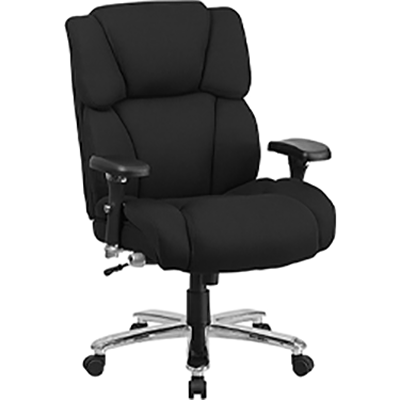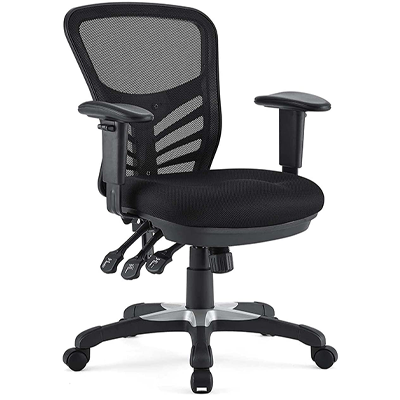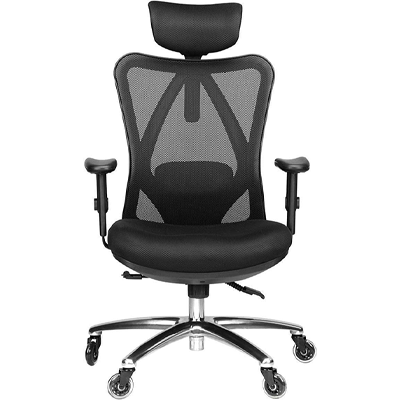Are you in the market for a new office chair? Are you overwhelmed by the sheer number of choices available? We get it, which is why we devoted an entire article to the topic of how to choose an office chair.
Start here, and we’ll step you through everything you need to know to help you cut through the clutter, quickly eliminate models that are just poor fits for you, and zero in on two or three “finalists” you can compare against each other, selecting the one you’ll be happiest with from that.
If that sounds good to you, read on, and let’s start putting together a sensible methodology that will shortcut your search.
How To Choose An Office Chair—Initial Considerations

Choosing the right office chair begins by asking yourself whether you genuinely want an office chair or if you’ll be willing to experiment with different kinds of seating. After all, there are other options available. You could get a stool, a kneeling chair, or one of those exercise balls to sit on.
All of those are viable alternatives to the conventional office chair. If you haven’t spent any time looking at the alternatives, you owe it to yourself to at least glance in their direction, if only so you can confirm to your satisfaction that no, that’s not what you’re interested in.
Assuming you’ve done that or are otherwise sure about what you want, the next step in terms of picking the right office chair is to break out your trusty measuring tape and take a few quick measurements. Specifically, you want to know:
- How high off the ground do you need the seat of your chair to be so you can sit in it with your feet firmly planted on the floor in front of you
- How wide your hips are, which will inform you how wide the seat in your perfect chair needs to be
- And how deep the seat should be

Armed with those facts, you’re well on your way to thinning the ranks. The next question is, how much do you weigh?
No, you don’t have to tell us, but you do need to keep that number in mind, and one of the first things you look at as you begin your quest of finding the right office chair is the amount of user weight it supports.
The good thing about the numbers you collect via the measurements above and your weight is that specific chair models are binary. They’ll either fit with the parameters these measurements create or won’t.
If they do, put them in your “maybe list.” If they don’t, then it doesn’t matter how much you may like them; they’re just not going to work for you, so set them aside.
How To Choose An Office Chair—Use Levels
The next thing to consider as you’re winding your way through the maze of possibilities on your way to choosing the right ergonomic chair for you is how much time each day you’ll realistically spend in the chair.
At the root, this is really about two things: the material that the base is made of and the upholstery.

Broadly speaking, you can break usage levels into three categories: light, moderate, and heavy.
Light usage would be 2-3 hours a day. Moderate usage would be 4-6 hours a day, with possibly a couple of 8-hour stints in the chair over a given week, and heavy usage would be anything more than 6 hours a day.
If you’d classify yourself as a “Light Daily Use” person, then get what you want. Even if your favorite chair has a nylon base, that’s fine. It doesn’t hold up as well as a solid steel base, but it doesn’t have to.
As long as your measurements are a good fit with the chair, then the upholstery won’t matter as much because you won’t be spending extended periods of time in the chair anyway. So if you’re a fan of leather or vinyl, go for it! It’s not breathable, but again, it won’t matter based on your average daily use.
If you’d classify yourself as a “Moderate Daily User,” then the sturdiness of the base and the upholstery on the chair starts to matter more.
At a minimum, you’ll want a reinforced, heavy-duty nylon base, but steel is even better.
In terms of upholstery, Moderate Daily Use is really where mesh shines because it’s breathable, and that’s going to help keep you cool and comfortable. Conversely, leather/PU starts looking less attractive because the longer you spend in the chair, the hotter and sweatier you’re going to get, and by the end of the day, you’re going to be hating it.

Fabric upholstery is a good middle ground and is the best choice for those who want some breathability but just don’t like mesh chairs.
Finally, if you consider yourself to be a power user and plan to spend long stints in the chair every day, you’re almost certainly not going to want leather/PU upholstery.
Fabric is likely the best choice because all mesh chairs have no padding, and at some point, the breathability becomes less important than some good, old-fashioned padding, although there is a caveat here…
Some mesh chairs use mesh for the seatback and a mesh-like material stretched over padding for the seat, giving you the best of both worlds. These are absolutely worth considering if you’re a power user.
And in terms of the chair base, steel is the optimal choice, but ruggedized nylon can work if you’ve really got your heart set on a particular model, and that’s the only base option you have.
How To Pick A Good Office Chair—Proper Positioning
When evaluating different office chair options, your best bet is to go to an actual showroom where you can physically try different chairs for size.

If you can’t do that, your next best bet is to remember exactly what you’re looking for and how you’ll (hopefully!) be using the chair in question once it arrives at your door.
When sitting in the chair, your feet should be firmly on the floor in front of you. Your back should be straight and the small of your back lightly pressed against the lumbar support pad—assuming you get a chair with lumbar support.
Your arms should be able to rest on the armrest, with your forearms extending toward your desk at a 90-degree angle from your body, where your fingers will find your keyboard.
Your monitor should be placed at eye level, so you neither have to bend forward and down to see the screen nor crane your neck up to see it. If you have a chair that allows you to sit like that, then it fits you like a glove. Don’t accept anything less.
How To Find The Right Ergonomic Chair—Features And Adjustability
Now, it’s time to talk about ergonomic features. These can take a variety of forms, but broadly speaking, ergonomic features fall into two basic categories: active and passive.

Active features are those you can adjust yourself—the seat height, the angle of the armrests, tilt angle, and the like.
Passive ergonomic features are those that are simply built into the chair and give you benefits simply by existing—the shape of the seat, armrests that are ergonomically sculpted, and so on. Also, note that some features are a bit of both.
A chair may come with a lumbar support pad, for instance, which is amazing all by itself, but it may also allow you to adjust either the level of support or the physical position of the support itself.
Generally speaking, the more ergonomic features a chair has and the more adjustable features, the better.
Ergonomics is actually the study of workplace efficiency, and a big part of that is comfort and proper posture, which is aimed at keeping you comfortable (and thus, more productive) throughout the course of a day.
If you pay attention as you sit in your current chair, you’ll note that you definitely don’t spend every day in essentially the same position. You move. You bend. You pivot, and you twist.

Your chair needs to be able to support you as you shift and change your seating position over the course of a day. Typically, a chair that has more adjustment options and boasts a greater number of ergonomic features can do that better than a chair with less.
Of course, not all ergonomic features were created equally, and your personal situation will no doubt shade and color how you view the major features a given model brings to the table. For example, if you already suffer from chronic lower back pain, then you’re definitely going to want an office chair that has dynamic, adjustable lumbar support.
On the other hand, if you have a long work table that goes from one side of your room to the other, then you may find that having a good tilt and lock and tension control, plus high-quality casters to allow you to roll freely, is the big keystone feature you’re looking for.
Or perhaps, you’re a little fidgety and want a chair with super adjustable armrests that allow you to adjust the angle at will.
Those are the kinds of things that only you can answer, and each person is different, so the “right” chair for you will undoubtedly be different than the “right” chair for me.
Case in point: the author of this piece is writing from a Flash Furniture Hercules 24/7 office chair with fabric upholstery. I spend 10+ hours a day in the chair, so I need fabric for breathability, good lumbar support—which this chair has—and an all-steel, ruggedized frame, which this chair also has.
I didn’t care about adjustable armrests or the rest of it. The Herc is perfect for me and is virtually indestructible to boot. If you’re shorter than 6’4” or so, it’s probably too big a chair for you, though, so it really does pay to take those measurements we talked about at the start and let them be your initial guide.
How To Choose An Office Chair—Conclusion
There’s a lot more to choosing the right ergonomic office chair than first meets the eye, and the sheer number of options on the market today can make the process feel daunting indeed.
It doesn’t have to be. The initial measurements we mentioned early on will help you thin the herd and focus on chairs that you know will be a good general fit for you. And then, your specific ergonomic needs and preferences, combined with how many hours a day you plan on using the chair, will guide you the rest of the way.
Follow those basic steps, and you’ll be staring at the perfect office chair for you in no time. Here’s to your good posture and productivity!
References & Resources:
- What is Ergonomics?, International Ergonomics Association.
- Ergonomics Expert Says Work Smarter at Home, Science Daily.
- How Ergonomics Increase Productivity, Lead Change.